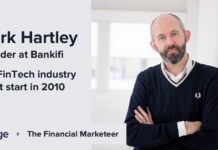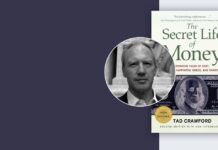Listen to the full interview with Patrick Muir
Interview with Patrick Muir
From assisting in the launch of the UK’s first-ever online bank to revolutionising the way Morgan Stanley markets its credit card products, Patrick Muir is one of the most experienced guests we’ve had on the show.
In this interview, Patrick tackles the topics of defining what financial marketing is, what is and isn’t disruptive, how the insurance industry has shot itself in the foot and how to succeed as a marketer regardless of whether you’re with an agile firm or an established global brand.
We start our conversation with a big one; what makes financial marketing different to other forms of marketing?
The rigid box
“We exist in financial services marketing in quite a rigid box for good reason. Laid down by various regulatory bodies, advertising standards, the law and in some cases depending on where you’re working, the brand you’re working within.”
That’s how Patrick begins to define financial marketing.
“As marketers, one of the big differences we have is we have to create and deliver very precise campaigns with zero margin for error inside this quite tight box.
“To be able to think creatively within that box requires very strong skills and knowledge in what makes up those boundaries.”
As a marketer in finance, “your regulatory knowledge has got to be very good, your legal knowledge has got to be very good and your financial knowledge about how the business model actually works has got to be very good.
“You’ve got to be able to talk that language to the experts in your company in those fields and if you can do that, the ideas that you have and the creativity that you have will be fed by that knowledge and not be knocked back by it.
“Every time you come up with an idea, you don’t want to be hearing from compliance, ‘no, you can’t do that’ and that very soon kills all of the creativity in that individual and eventually in the team.”
Producing a set of signed-off ‘laws’
Clearly, working as a marketer in finance comes with responsibility, so I was keen to understand how Patrick has gone about managing that responsibility.
“In my first proper direct marketing role…I’d been asked to go and get some stuff signed off by the Head of Legal and full of enthusiasm I went into his office asking for a sign-off and I just got this tirade of abuse.
“I thought, ‘I don’t want to go through this again’ so I said to him straight away, ‘I’m just learning some of this stuff so what if I write a tip-sheet for the common mistakes and what you don’t want to see and what should be in place every time it comes in for a sign-off. If you sign off my tip-sheet…I promise I’ll never bring in anything again that transgresses any of these laws’.
“I carried that [approach] through, so when bringing other people into the industry I encourage them to write their own version of [the tip-sheet].”
The tip-sheet approach means that Patrick and the teams he works with can always be cognisant that “from a regulatory and a legal point of view these are the things that must always be in place.
“The act of writing it down, understanding it and having it signed off by your own internal legal people just cements it in your head that that’s always got to be the case.”
Building a relationship with the finance team
Patrick moves onto explaining the importance of understanding the economic framework that your role exists within and how to go about making that work for you and your marketing efforts.
“At Morgan Stanley, we had a woeful relationship with the finance team…what you sometimes find in businesses is the marketing team claim successes and then the finance team sits there grumbling that actually what you say is a success has cost us money and isn’t doing as well as you think it is.
“Building models for financial impact that finance has signed off…so that when someone says something, everyone else is broadly in agreement is hugely helpful to the CEO.
“Nothing drives a CEO more mad than them saying to their finance team, ‘I see the latest campaign from marketing looks like it’s been a great success’ and finance saying, ‘our guys have looked at it and it’s been a disaster’.”
A declining influence of marketing in financial services
“One of the things that I’ve observed in the last seven or eight years is the degree to which marketing has become less influential in financial services.
“Faced with a tsunami of different regulatory changes, financial changes and financial challenges marketing has become, in many businesses, lead generation as opposed to having an influence about…what products we should be selling, how we should be selling them, who we should be selling them to.
“The only way of getting that back is by having your feet underneath the ‘big table’ and being able to talk risk, analysis, customer and finance with those communities.”
Marketing is not a business function
Patrick is keen to express that marketing is more than just a business function. “Marketing is an approach to business…so the idea of understanding your customer, designing products that meet a customer’s needs profitably and then being able to present the customer with that product through the right channel at the right time and measure it all is the essence of it.
“When you get to the very big companies they tend to operate in huge global manufacturing silos because their model says that’s the most efficient way of operating it…then marketing is a country activity that cuts across that.
“I have experience of trying to get feet under the table of the bigger conversation in those environments and it’s not easy because you have no right to do it. So you’re either in an organisation that’s marketing-led in which case you have an authentic and powerful voice at the table…or, if you’re in a big company with these big global silos you have to become a bit like a Henry Kissinger and strike deals with people.”
Marketing the first digital bank
One of Patrick’s defining career moments was in taking charge of marketing the launch of Egg, the first digital bank, something that grew out of a fledgling telephone banking brand.
“If we’re going to be an internet bank, the place we need to show up and innovate is…the internet. So we created a model where the TV advertising and the internet advertising were the spindles around which the other marketing went round.
“Internet marketing, early on, was maybe a banner on AOL’s ISP or Freeserve with a homepage takeover and basically what you did is you went in and got a whole stack of inventory from one of these ISPs…and you got X million eyeballs and some of that was good, some of it was less good.”
Patrick told me about the challenges he’s faced in his career with claiming advertising space in a competitive market.
“…if you’re selling personal loans and you’re doing inserts into magazines the best place to stick those is in car magazines but Alliance & Leicester, who were doing a lot of loans business back in the 90s had bought up the rights to do that with [the car magazines] for years so we couldn’t get in [when I was at] Lombard at all.
“I thought, ‘I don’t want that happening to us with Egg’ so we did deals where we were buying up the rights to market certain financial services products on ISPs for a year; we basically bought the internet.”
Building disruptive products and brands
“Marketing has to show up. Communications have to cut through. Unless it does that, nothing happens at all. To do that, you’ve got to maybe take a risk either with the punchiness of your product or how you’re presenting it,” explains Patrick.
“There’s always a fine line between being punchy and cutting through and upsetting people…but it’s that disruptive attitude that means you’re putting stuff out there in the world for people to react to in marketing.”
Patrick stresses the importance of being heard, “unless you’re looking to get a reaction, you’re wasting time and money.”
I ask Patrick about his thoughts on the concept of ‘disruption’ in marketing. “You hear ‘disruption’ used a lot…if I’m honest, it’s not clear what people are challenging anymore. We were lucky at Egg because we hit the right point at the right time with the internet…that was our thing, we were revolutionising customers’ experience of financial services through the power of the internet.
“I just wonder how many ‘challenger’, disruptive businesses out there at the moment actually are really clear on what they are disrupting and why.
“Just handing Google or Facebook a couple of million [pounds] to send you the traffic that they deem through their algorithm is what you should be having doesn’t feel very disruptive…so I think [the term] is overused and underused; it’s overused in terms of people saying it, but it’s underused in people delivering it.”
Insurance has become just meerkats, superheroes and opera singers telling you to get a quote
Patrick is also involved with a startup called Sherpa which operates within the insurance sector. I ask him about his experience here and his thoughts on how to disrupt an industry like insurance.
“What the insurance industry has done is basically alienate themselves from their customers. The original purpose of insurance is to basically indemnify you against risk to the point at which you can carry on living [even if] the worst has happened [because] you’ve been protected financially from the results of it. It’s a really powerful thing.
“All of the innovation in insurance has been around how you can get more quotes for things [and that means] the actual ‘value’ of insurance has disappeared and people’s knowledge of it and what it’s doing for them and whether they have the right amount in the right areas has just completely gone.
“It’s just meerkats, superheroes and opera singers telling you to get a quote.”
Patrick explains why he sees Sherpa as such an exciting business in this space. “In the same way as a credit score, [Sherpa] shows you your score out of 100 in terms of [where you’re well covered and where you’re not].
“[Sherpa] is a model that produces a score that helps people understand their personal risk environment and what they can do, and what they can do isn’t always ‘buy another policy’, it could be ‘increase your savings by £50 per month.
Disruption at Morgan Stanley
Having experienced working with so-called ‘disruptor’ brands such as Sherpa and Egg, I was also keen to get Patrick’s take on potentially less-obviously disruptive firms such as Morgan Stanley. “Disruption doesn’t always have to be shouty…what actually Morgan Stanley was about was around consumption, being a really great way to pay for things [rather than just as a balance transfer credit card solution].
“The problem with the balance transfer stuff is that people just do their balance transfer and then stick the card in a drawer whereas what we were about was transactions…so aligning the consumer bank with that [and away from just balance transfers] was actually quite simple when we thought about it.”
This realisation enabled Patrick and his team to completely shift the way Morgan Stanley marketed its credit card products. “Everything was about something that’s the best way to pay…so we chose that we’d go up against American Express. We’d produce a card that was better for cashback and had better insurance products attached to it.
“That provided an internal narrative for the team [so they knew], we’re not worried about what Barclaycard or NatWest are doing…we’re producing cards that people will want to use and they’ll put the other stuff in a drawer.”
Generating a reaction
Perhaps most clear from our conversation was Patrick’s belief that marketing’s most important role is to elicit a reaction from its intended audience, whether that’s internal teams or external customers.
“[Your marketing] has to generate a reaction because that is ultimately what marketing is all about…so make sure your team knows it, make sure that that’s what the other people in the organisation in different functions know, make sure you’ve got agencies on board and are capable of doing that and take some chances.”
“Never ever forget in marketing, it’s an incredible privilege, whether you’re producing a mail pack, a loose insert, a banner that’s going onto a website somewhere or a great big kick-ass TV campaign, you’re putting stuff out there for the world to see.
“To do stuff like that that you can point to and say, ‘I did that’ is an enormous privilege and we should never forget that and therefore [you must] treat it with the respect that it deserves to produce the very best work that we can.”











